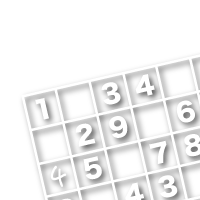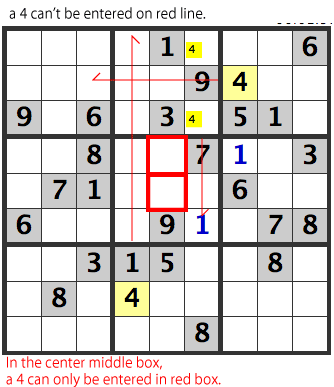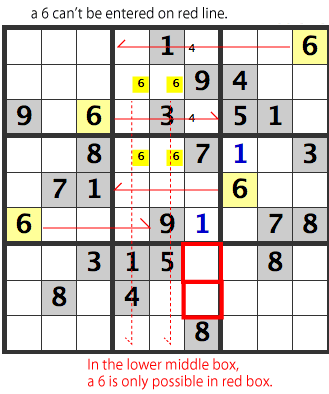

Sponsored Links
TOP > Techniques > Pointing Pairs
Solving Techniques 4
Pointing Pairs
It often happens that the possibilities of boxes, rows and columns have been exhausted and eight cells are filled with two remaining (the technique also works with three remaining). Also, there are cases where the two remaining cells are next to each other either in a row or column. This technique can be applied in these cases.
Pointing Pairs
Let’s look at the upper middle box. There is a 4 in [R8C4], so it can’t be entered in the 4th column.
Also, since there is a 4 in the second row, [R2C7], a 4 can’t be entered there.
Hence, the cells where a 4 can be entered in the upper middle box, are either [R1C6] or [R3C6].
Therefore, in the center middle box, a 4 can only be entered in column 5.
As you can see, in pointing pairs, you look for pairs or triple numbers and eliminate the possibility of them belonging in other cells.

Sponsored Links
Pointing Pairs-2
In the upper middle box, a 6 can only be entered in row [2].
Similarly, in the center middle box, a 6 can only be entered in row [4].

Now that we have a [6,6] pair in the upper middle box, a 6 can’t be entered in the lower middle box’s columns 4 and 5.
Hence, in the lower middle box, a 6 is only possible in column 6.
As you can see, this is a technique of slowly narrowing down the candidate numbers.
Names of cells in Sudoku
| R1C1 | R1C2 | R1C3 | R1C4 | R1C5 | R1C6 | R1C7 | R1C8 | R1C9 |
| R2C1 | R2C2 | R2C3 | R2C4 | R2C5 | R2C6 | R2C7 | R2C8 | R2C9 |
| R3C1 | R3C2 | R3C3 | R3C4 | R3C5 | R3C6 | R3C7 | R3C8 | R3C9 |
| R4C1 | R4C2 | R4C3 | R4C4 | R4C5 | R4C6 | R4C7 | R4C8 | R4C9 |
| R5C1 | R5C2 | R5C3 | R5C4 | R5C5 | R5C6 | R5C7 | R5C8 | R5C9 |
| R6C1 | R6C2 | R6C3 | R6C4 | R6C5 | R6C6 | R6C7 | R6C8 | R6C9 |
| R7C1 | R7C2 | R7C3 | R7C4 | R7C5 | R7C6 | R7C7 | R7C8 | R7C9 |
| R8C1 | R8C2 | R8C3 | R8C4 | R8C5 | R8C6 | R8C7 | R8C8 | R8C9 |
| R9C1 | R9C2 | R9C3 | R9C4 | R9C5 | R9C6 | R9C7 | R9C8 | R9C9 |
Sponsored Links

